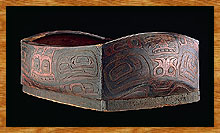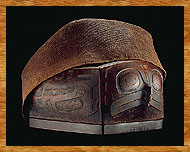(page 1 of 2)
 Ladles and Ladles and
 Horn Spoons Horn Spoons
 Food Dishes Food Dishes
 and Bowls and Bowls
 Bentwood Trays Bentwood Trays
 and Serving and Serving
 Dishes Dishes
 |
Bentwood Trays and Serving Dishes
A variety of containers for the feast, including trays and serving dishes, were made by the bentwood technique, in which a single plank was steamed, kerfed and bent at three corners, then pegged together at the fourth. Bases were morticed and pegged to the sides.
Shallow rectangular bentwood trays were standard items at a feast. Some large trays for serving smoked or roasted fish were up to 1.5 m (5 feet) in length. The sides were often of alder, and the bottom was generally red cedar. The shape of the top of the rim alternates between concave and convex on each of the four sides. Most trays have a raised flat pedestal at each end, on which to rest spoons.

 |
A deep bentwood food dish. The design on it, originally painted in black and red, is that of a Whale with Nansimget hanging onto its head. Large feast dishes like this one could hold an entire 22.7-kg (50-pound) roasted salmon.
Collected at Skidegate in 1897 by Charles F. Newcombe.
CMC VII-B-739 (S92-4266) |

A deeper version of the bentwood tray is actually a serving dish, ranging from large shallow-sided soup dishes to deep-sided boxes for berries or crabapples in eulachon grease. These bentwood dishes were often made in the shape of animals or humans, with faces and hands at one end, and hips, legs and feet at the other. The sides of the dishes bulge out, considerably enhancing their zoomorphic nature, and are usually embellished with two-dimensional bas-relief carving or painting. Some examples position the decorative figures upside-down, but the majority are right-way up. The most elaborate example has a sculptured face and tail on the ends and bas-relief arms, legs and hip joints on the bulging sides. This type of bentwood dish is often so animated in design and execution that it appears to be alive. Covers made of tightly woven cedar bark were used to keep dirt and insects out of the food.

 |
A bentwood food dish with its cover of woven cedar bark. The main figure is that of a Hawk; at the opposite end is an inverted human figure. This dish belonged to Chief Klue of Tanu, who took it with him when he moved to Skidegate.
Collected in Skidigate circa 1900 by Charles F. Newcombe.
CMC VII-B-740 (S92-4270) |

These highly stylized bentwood dishes are derived from birchbark prototypes. The large squarish end panels recall the folded end panels of the ancient birchbark form and provide an appropriate field for a crest design, usually the faces of animals or even humans in bas-relief. Examples of early birchbark containers, excavated at wet sites in Prince Rupert harbour, date back more than 2,000 years. No wet sites have been excavated on Haida Gwaii, but a similar minimal age is indicated.
The rim is decorated with a band of vertical reeding, which also echoes the construction of earlier birchbark trays, as well as with opercula, sea otter teeth, abalone shell or brass tacks. Below the reeded band is a very narrow zone for the formline design, demonstrating the extreme to which the face of a supernatural being can be stretched. On some dishes, the face is upside-down so that the opening of the container appears to be the wide-open mouth of the creature. Such dishes were probably used for soups or stews for a group of people. They were watertight, and food could be cooked in them by using heated stones to boil water.
|